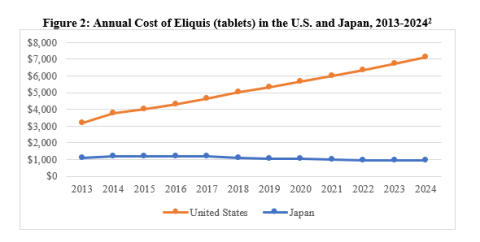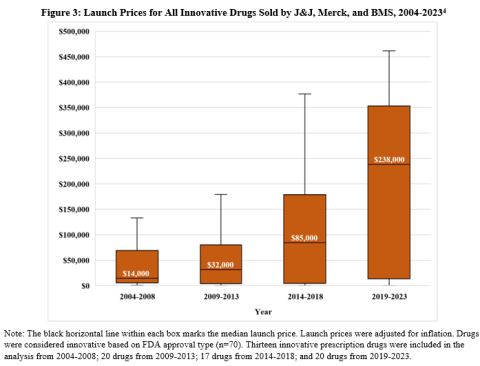Big Pharma’s Business Model: Corporate Greed
WASHINGTON, Feb. 6 – Sen. Bernie Sanders (I-Vt.), Chairman of the Senate Committee on Health, Education, Labor, and Pensions (HELP) released today a new report detailing the rigged system that allows Big Pharma to charge Americans the highest prices in the world for prescription drugs.
The HELP Committee Majority Staff uncovered how three U.S. pharmaceutical companies — Johnson & Johnson, Merck, and Bristol Myers Squibb — profit at the expense of the American people. The report documents how these companies make billions of dollars by charging Americans the highest prices in the world. The profits they make selling some drugs in the U.S far exceeds the money they make in the rest of the world combined. The report also systematically analyzes the launch prices of innovative prescription drugs sold by Johnson & Johnson, Merck, and Bristol Myers Squibb since 2004 to reveal how these companies are charging exponentially higher prices in the U.S. than they did twenty years ago.
To read the full report, click here.
To read the summary, click here or see below.
Note: Footnotes found in full report linked.
Key Findings Include:
- The pharmaceutical industry is enormously profitable, with companies like Johnson & Johnson, Merck, and Bristol Myers Squibb raking in tens of billions of dollars every year.
o In 2022, Johnson & Johnson made $17.9 billion in profits and its CEO received $27.6 million in compensation. That year, the company spent $17.8 billion on stock buybacks, dividends, and executive compensation, compared to just $14.6 billion on research and development (R&D). In other words, the company spent $3.2 billion more enriching executives and stockholders than finding new cures.
o In 2022, Bristol Myers Squibb made $6.3 billion in profits and its former CEO made $41.4 million in compensation. That year, the company spent $12.7 billion on stock buybacks, dividends, and executive compensation, compared to just $9.5 billion on R&D. Just like Johnson & Johnson, Bristol Myers Squibb spent $3.2 billion more enriching executives and stockholders than finding new cures.
o In 2022, Merck made $14.5 billion in profits and its CEO made $52.5 million in compensation. That year, the company spent over $7 billion on dividends and executive compensation, and $13.6 billion on R&D. If Merck’s cancer drug Keytruda was its own company, its 2022 sales would rival McDonald’s annual revenue, and exceed the revenue of the hotel chain Marriott. - The current industry business model is based on ripping off the American people. For some of their most popular drugs, Johnson & Johnson, Merck, and Bristol Myers Squibb made more money in the U.S. than the rest of the world combined.
o Since 2016, Johnson & Johnson made twice as much selling the arthritis treatment Stelara in the U.S. ($30.4 billion) as it did in the rest of the world ($14.9 billion).
o Since 2015, Merck made $43.4 billion selling the cancer drug Keytruda in the U.S. compared to $30 billion in the rest of the world.
o Bristol Myers Squibb made $34.6 billion selling the blood thinner Eliquis in the U.S. compared to $22.5 billion in the rest of the world, meaning that the U.S. accounts for nearly two-thirds of all global Eliquis sales since its launch. - Johnson & Johnson, Merck, and Bristol Myers Squibb charge Americans, by far, the highest prices in the world for prescription drugs. They begin by setting exorbitant prices for new drugs. Then, as patients come to rely on these drugs, these companies raise prices, forcing patients to pay more or abandon ongoing treatment.
o Merck began selling a vial of Keytruda in 2015 at an annual cost of $147,000 in the U.S. and $132,000 in Germany. While Keytruda now costs just $89,000 in Germany, it costs more than twice as much in the U.S. at $191,000.

- Bristol Myers Squibb began selling Eliquis in 2013 for an annual cost of $3,100 in the U.S. but just $1,000 in Japan. The price of Eliquis in Japan went down to $900. In the U.S., Bristol Myers Squibb more than doubled the original price to $7,100.

- Over time, higher launch prices, combined with price increases, have led to staggering differences in U.S. prices compared to prices in the rest of the world.

- Johnson & Johnson, Merck, and Bristol Myers Squibb are not just charging higher prices in the U.S. compared to other countries. They are also charging Americans much more than they did in the past.
o From 2004 to 2008, the median launch price of innovative prescription drugs sold by Johnson & Johnson, Merck, and Bristol Myers Squibb was $14,000. Over the past five years, the median launch price of innovative drugs sold by these three pharmaceutical companies was $238,000..

- Johnson & Johnson, Merck, and Bristol Myers Squibb try to preserve their pricing power by any means necessary.
o The companies have built patent thickets to extend their monopolies and delay low-cost generic competition, according to a database compiled by patent lawyers called the Drug Patent Book.
o 168 patents have been filed on Merck’s Keytruda. 64% of these patents were filed after the drug first received F.D.A. approval.
o 57 patents have been filed on Johnson & Johnson’s Stelara. 79% of these patents were filed after the drug first received FDA approval.
o The companies have spent enormous amounts of money to buy influence. Over the past twenty years, Johnson & Johnson, Merck, and Bristol Myers Squibb spent more than $351 million on lobbying, and $34 million on campaign contributions. Last year, these companies sent nearly 200 lobbyists to Congress. - The federal government is beginning to take on the greed of the pharmaceutical industry. Medicare, for the first time, can negotiate the price of drugs like Eliquis and Stelara. Manufacturers are also now required to pay rebates to Medicare for increasing prices faster than the rate of inflation. But much more must be done to make medicines affordable for all Americans.
